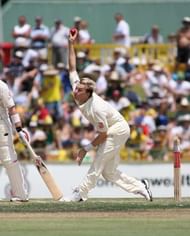Over the past few years, several bowlers have suffered injuries and very often this injury has ruled them out for a very long time. Even in the ongoing series between India and Australia, Mitchell Starc had to be ruled out owing to the injury to his foot. This came even as Starc made his comeback after quite a long time in the Sri Lanka series. It is a crying shame that the left-armer could not quite go on to play a decisive role in the Australian team for in the ongoing series.
Mitchell Starc is not an isolated example, there have been several examples of fast bowlers who have broken down and their careers have stalled completely.
So what exactly is the reason behind the sudden spurt in the injuries these bowlers are suffering with?
The answer to this question is right in front of our eyes and it plays out during every cricket match.
It is the front foot no-ball rule which could be the cause of concern for the injuries to so many bowlers. Well, this rule has even perplexed the umpires for good measure!
If a new book authored by Australian journalist Doug Ackerly is to be believed, this front foot no ball is the sole reason why so many injuries are slicing through bowlers.
Ackerly spent nine years researching the no-ball rule, it’s implementation and gives an exhaustive account in his new book, Front Foot: The Law That Changed Cricket.
How has the law changed?
Before 1963, the no-ball rule was far different than the current version. According to that rule, the back foot of the bowler had to land behind the bowling crease, which is where the stumps are planted.
The rule went on to state that as long as the back foot landed behind the stumps line the delivery was fair even if the front foot dragged on in front of the batting crease. However, if the bowler cut the return crease which runs parallel to the stumps on either side, the delivery is deemed to be a no ball.
This rule was changed after 1962 as lawmakers believed that the bowlers are taking undue advantage of the front line by sliding their back foot forward, thereby gaining an advantage.
Once the change was made, and a new set of diktats were put into place which emphasised on where the front foot landed, clearly stating it couldn't be plonked over the popping crease. Subsequently, bowlers started tweaking their actions and their routines to work around this new concept.
Smoother actions made way to exaggerated leaps and sudden brakes before delivering the ball. According to the Ackerly, this jumping and braking practice increases the load on the front foot and body exponentially. Owing to this front foot rule the impact on the front foot is almost 7 times the body weight. For instance, if the weight of the player is 50 kgs, the impact on the front foot amounts to 350 kgs every time he strides out to bowl!
Compare this to the back foot landing and the old rule and this weight transition reduces to 5 times the body weight!
Hence, the ball is now firmly in the court of the International Cricket Council as they have to seriously look towards this aspect with great care and concern.
Former Australian cricket captain Ian Chappel has also been a vocal advocate of going back to the back foot no ball. He argues in favour of the old rule on two counts. One, it makes the job easier for the umpires as they do not have to focus on the front foot at all times which in turn would help them concentrate at the batsman’s end. The other one is basically the injury concern to the fast bowlers which is only on the rise.
Your move, ICC!
Follow IPL Auction 2025 Live Updates, News & Biddings at Sportskeeda. Get the fastest updates on Mega-Auction and cricket news



